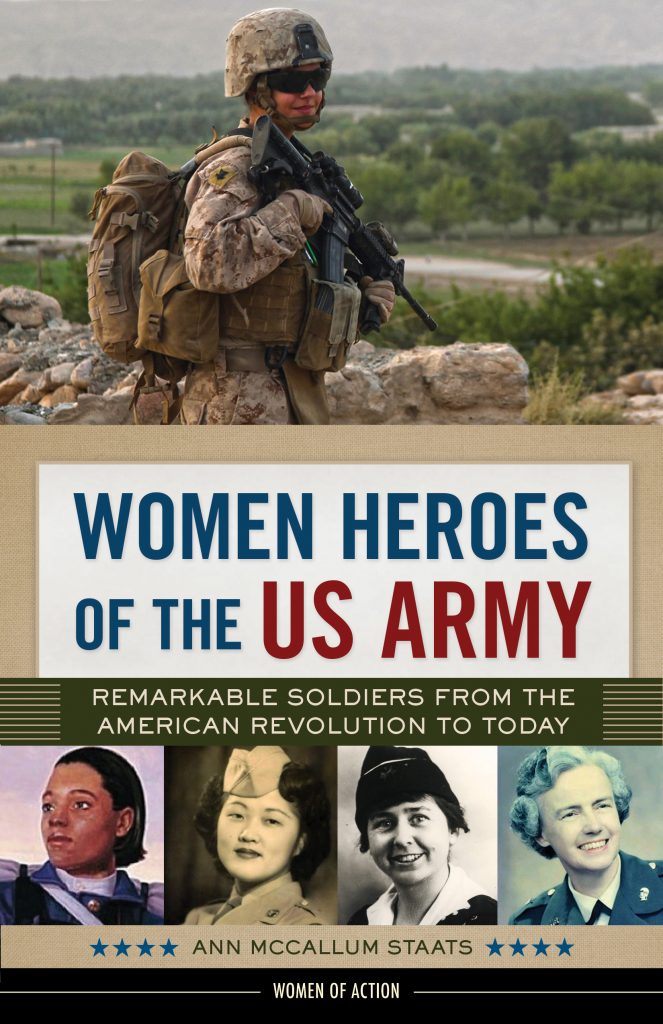In our interview with author Ann McCallum Staats, she reveals the most surprising stories she discovered during her research as well as her process and inspiration for writing Women Heroes of the US Army. Read below to learn more!

Women Heroes of the US Army includes profiles from a wide variety of women throughout history, from the groundbreaking women soldiers of the American Revolution to our modern-day fearless leaders and role models. During your research, what facts or stories were you most surprised to learn about?
First, the early history was really amazing. The fact that so many brave women went against societal norms during the Civil War to illegally enlist is fascinating. Then, during World War I, women such as chief telephone operator Grace Banker were so eager to do their part, despite the very real danger of bombs and guns near the front lines in France. I am in awe of Oveta Culp Hobby, the highest-ranking female and first director of the Women’s Army Corps (WAC), and how the “Little Colonel” had to wash and iron her blouse every night during her grueling schedule of travel because the army supplied her with only one uniform. And what must it have been like for Charity Adams Earley, commanding officer for the only African American WAC unit overseas during WWII? A story that comes to mind is that, when bombarded with too many male visitors, Charity had the front legs of an office chair cut short so that guests had to uncomfortably lean forward—hopefully deterring them from staying too long. Overall, I guess you could say that I was surprised to have an insider’s peak into the lives of these women who started out as ordinary people but quickly built extraordinary lives.
What inspired you to write Women Heroes of the US Army?
Before I wrote this book, I didn’t know much about the army. I barely knew the difference between a private and a second lieutenant. And never mind the difference between enlisted and commissioned personnel. Sure, I’d watched TV and seen soldiers patrolling places all over the globe, but I’d never really thought about this culture of the military. However, the more I read, especially about how women were making an enormous impact, the more I wanted to know. Margaret Yang who, despite witnessing the horror of Pearl Harbor, immediately enlisted. Mary Hostetler, was the first female criminal investigations agent to serve on a protective detail to top leaders in Iraq, including presidential envoy, Paul Bremer. I knew I needed to learn more about these women. It was, and continues to be, a fascinating journey.
What was your process for choosing which women to feature and what angle to approach their story from?
For the earlier women, I did a lot of reading and tried to choose people from each time period who had left a clear record of what they had accomplished. I read about far more women than I was able to use in the book. Similarly, for the contemporary women, I spoke to many more women than I could fit in the book. I ended up choosing women who piqued my curiosity, but whom I also admired as people. All the women highlighted are truly kind and generous people, patriotic and selfless. I appreciate their honesty and dedication. When either reading or interviewing, I looked for challenges each had faced but then overcome. I wanted to show each as a regular person who had made decisions and sacrifices in order to serve.
What do you hope kids (and adults) take away from reading this book?
Corny as this sounds, writing this book filled me with a kind of hope for the world. I would wish this same feeling on the readers of the book. How can regular and ordinary people make an impact, no matter their start in life? For example, Celia Adolphi grew up on a farm in Indiana. Her parents were neither wealthy nor connected. Yet Celia earned her place as the first female two-star major general in the US Army Reserve. Like Celia, how can everyday people contribute to the world? Perhaps by reading the stories of these women, a reader will be inspired to follow a difficult dream.
What five people—living, dead, fictional or nonfictional—would you have over for a dinner party and why?
First and foremost, I’d have my family over so that would take up more than my five allotted slots. But, if I were given five additional seats, I’d invite the following: Jesus; an early astronaut such as Neil Armstrong or Buzz Aldrin; the first James Bond actor, Sean Connery; and two authors—so hard to choose, but maybe JK Rowling and Suzanne Collins. Two of the invitees are based on childhood obsessions: to be an astronaut and to live a life of adventure like James Bond. With all of the guests, I would love to pick their brains, though I’d probably be too thunderstruck to get in many coherent questions.
No Comments
No comments yet.